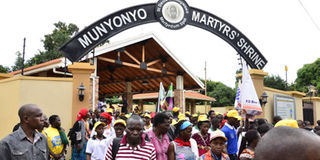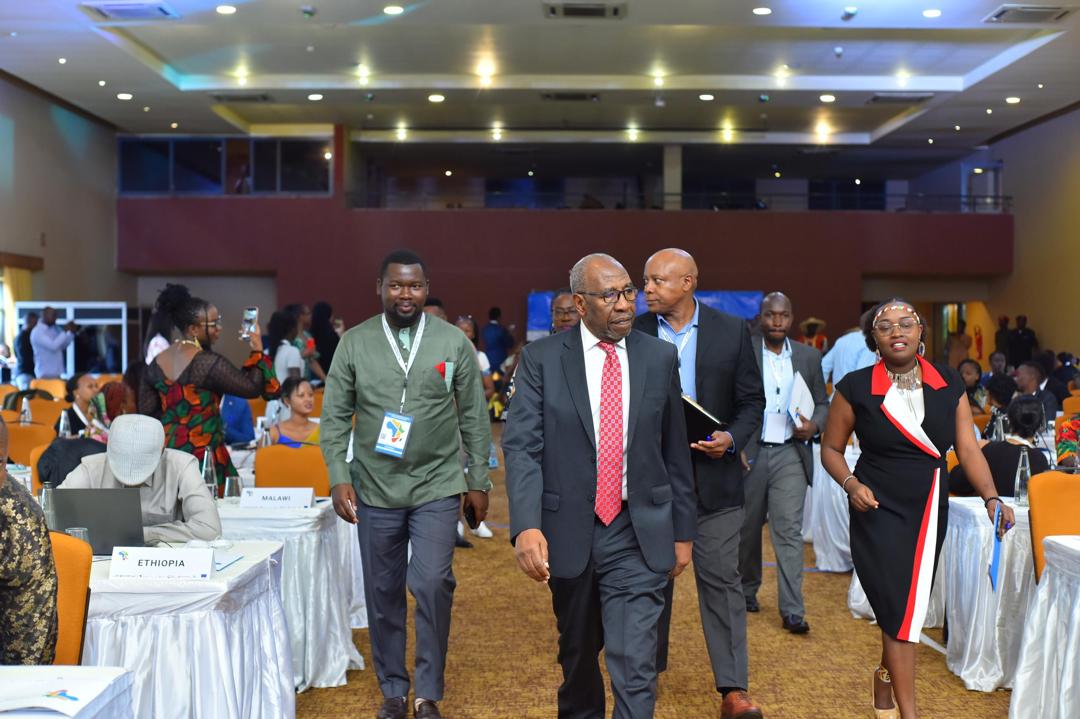Prime
Munyonyo’s journey from bushy church to minor basilica

Pilgrims march out of Munyonyo Martyrs Shrine in 2017. The place attracts thousands of pilgrims every year. PHOTO BY ALEX ESAGALA
Uganda will be the only country in Africa to host three minor basilicas under the Catholic Church when Munyonyo is declared a minor Basilica tomorrow.
Apart from Munyonyo, the country is host to the Uganda Martyrs Minor Basilica in Namugongo and the Minor Basilica of the Blessed Virgin Mary in Lodonga, Yumbe District under the Arua Diocese.
Fr Ulman Male says a minor basilica is a church granted with special ecclesiastical privileges by the Pope. The status is usually given to churches because of their antiquity, historical value, architectural worth and the way sacraments are celebrated.
We present the intricate journey of Munyonyo’s rise from a tree shade church to a minor basilica, and also trace the rich history of other minor basilicas.
Today, from the time you set foot on the Munyonyo Hill, you can sense eminent holiness, desiring never to leave. As you make your way through the gate, the feeling of simplicity and nobility comes your way.
The winds create a rhythmic wave among the trees that you wish to stay there in meditation all day long.
Munyonyo Martyrs Shrine
Built on 12 pillars to symbolise the 12 apostles, Munyonyo Martyrs Shrine is in a circular shape with a metallic cross of about 47 metres mounted at the roof top.
Its interior is stunning, the terrazo floor leads to a bright marble altar with a tabernacle built within the wall. The door to the tabernacle is coated with a gold layer. It has the symbol IHS mid-relief with a sun design that is complete with vivid rays coming out from each side. The inside of the tabernacle is coated with a marble layer.
However, the place that was neglected for more than 127 years, has in less than five years attracted thousands of Christians converging for prayers every Sunday.
“The first congregation at this place was of about 20 people. At that time, we did not have a parish priest. Mass was led by the late Emmanuel Lukwago, a catechist in the 1960s,” Joseph Ssali, 86 one of the first people to converge for prayers at Munyonyo, recalls.
Ssali says the catechist would read to the congregation the order of Mass from the missal (The book used by the priests during Mass). This continued until 1970 when the late Fr Ssemanda (Ssali was not able to recall his first name) was appointed from Nsmbaya parish to lead the congregation in Munyonyo.
To a congregation of less than 20 people, Ssali says this was a dream come true. Under a tree shade where Andrew Kaggwa is believed to have been martyred, a small table covered with a strachitsa and inditia (altar cloth) was prepared for an altar. Maneuvering through the bushy area, Ssali says the priest carried a small briefcase containing a vestment, host, chalice, chibolioum, missal and lectionary, which were used during Mass.
“I witnessed how jolly everyone was during Mass,” he recalls.
However, the jubilations did not last.
“It was not long before the late Fr Ssemanda started complaining about the bushy area, the irregular attendance of the congregation, the distance and worst of all the distraction from monkeys that were all over the place,” Ssali reveals.
“Fr Ssemanda said he could no longer lead Mass from such a place,” Ssali says. Angry at the priest, Ssali recalls his later mother, Elizabeth Nakabuye, yelling back at the priest: “We will also give birth to priests.”
Reaching out to the then Nsambya parish priest, Ssali says in 1972, Munyonyo sub-parish was put under Ggaba parish.
“A new priest from Ggaba parish was appointed to lead Mass, but even then we were still small in number,” Ssali recalls.
Visiting different homes, Ssali started mobilising fellow Christians to gather for prayers. Every Saturday, Ssali took on the obligation to slash under the tree from which prayers were held.
Ssali says this continued until the late Cardinal Emmanuel Nsubuga, together with the congregation, constructed a permanent chapel with a sitting capacity of about 20 people.
“During the visits of the two Popes to Uganda, Munyonyo was known to only a few people,” Ssali claims.
However, in the recent years, the area has been transformed by the arrival of Pope France, who happens to be the third pope to visit Uganda.
Ssali compares Munyonyo to the biblical teaching in Psalm (188:22) that says: “The stone that was rejected by the builders has become the head of the corner”.
Outshined by Namugongo Martyrs Shrine, Rev Fr Ulman Male, a Polish-born cleric, says Munyonyo had been forgotten and less talked about yet it is where the Uganda martyrs started their journey headed for execution at Namugongo.
“I came to Munyonyo in 2013 and was appointed parish priest in 2016. However, at the time all that was here was a small chapel. Where the church stands today was a forest,” Fr Male recalls.
In 2013, the shrine was entrusted by Archbishop Cyprian Kizito Lwanga to the Order of Friars Minor Conventual, also known as the Conventual Franciscans, which is a mendicant Catholic religious order that was founded by St Francis of Assisi in 1209.
Fr Male reveals that the official ground-breaking ceremony of this historical place was done by the Papal Nuncio to Uganda, Archbishop Michael August Blume and Cardinal Emmanuel Wamala on May 3, 2015. It was then dedicated by his Eminence Cardinal Filoni in 2017.
In honour of Pope Francis’ pilgrimage, in June 2016, Munyonyo was declared a parish by Archbishop Cyprian Kizito Lwanga, thereby making it the 64th catholic parish in Kampala Archdiocese. As a parish, Munyonyo takes St Ponsiano Ngondwe Sub-parish Kyamula. The new parish is headed by the Franciscans Fathers, a religious congregation in the Catholic Church.
Tomorrow, Munyonyo Marty’s Shrine will adopt the name Uganda Marty’s Basilica Munyonyo, becoming the 23rd basilica in Africa.
Minor Basilica of the Blessed Virgin Mary - Lodonga, Arua Diocese
It was founded in 1927 by the Comboni Missionaries, and made a minor basilica in 1961. It is located in Yumbe District under the Lodonga Parish and Arua Diocese.
Fr Emmanuel Asega, the parish priest at the minor basilica, says it was constructed in the old Romanique architectural style and is in line with the original churches where the apostles were buried. The painting is also in communion with the major basilicas in Rome.
The church floor has terrazzo works and the presbytery was changed according to a new directive from Rome. It is also decorated with a vault and a marvelous design of a beehive. A complete ceiling and a winding staircase were constructed for the choir platform.
The minor basilica can accommodate up to 1,000 Christians at a time
Fr Pietro Valcavi initiated its construction in 1944, and it was completed in 1946. Monsignor Angelo Negri had objected to the idea when presented with the initial architectural plan. He thought the church was too big and there were no funds to facilitate the construction.
However, Valcavi convinced Negri and he approved the plan and its construction was kick-started, which lasted for two years amidst financial challenges.
According to Fr Asega, it was difficult to establish Christianity in West Nile region because of a strong pagan culture and Muslim influence in the area.
Fr Bernado Satori, who joined the mission in the 1930s, realised his predecessors had tried to break the pagan influence but had failed. Fr Satori decided to devote himself to Mother Mary. He also dedicated the church to Her care and requested a statue of Her from Rome, which was brought to Lodonga.
“The devotion to Mary had key breakthroughs,” Fr Asega explains.
“Fr Satori realised a big enrollment of Christians who were increasing in a strange manner. The number of believers rose from 17 to 300 in a short time. More Muslims also got converted. That is why the church was constructed.”
This breakthrough encouraged Bishop Negri to apply for a basilica status from the Vatican. On May 26, 1960, the Vatican, after thoroughly assessing the conditions, granted Lodonga a minor Basilica status. It was dedicated to the Virgin Mary and was named Minor Basilica of the Blessed Virgin Mary, Lodonga. It was declared a minor basilica in 1961, making it the first basilica in Uganda.
Fr Asega says the success of the initial envagelisation exhibited signs of God’s intervention, in a place where most people thought envagelisation could not succeed.
The main conditions for granting Lodonga a minor basilica status was its architectural significance and the intervention of Virgin Mary.
Fr Asega says having a basilica is a blessing. “We feel thankful to God to have a basilica. It was surprising that Lodonga was situated in one of the remotest places in Uganda. We have Christians and non-Christians praying from here. This is where they find solutions to their problems, they are particular in guarding the place,” he says.
Uganda Martyrs minor Basilica - Namugongo
Its religious significance remains etched in the minds of millions of pilgrims across the globe, who visit the towering Uganda Martyrs Minor Basilica in Namugongo on June 3 every year.
Ben Tenywa, a pilgrims’ guide at the basilica, says Pope John Paul VI laid its first foundation in 1969, and declared the Uganda martyrs’ saints. The shrine was completed in 1975.
Commonly known as the Uganda Martyrs Catholic Shrine, its website describes the minor basilica as circular church of 42-metre diameter inspired by the looks of an African hut and the first of its kind in Africa.
It has 22 pillars made of seamless steel, each representing a Catholic martyr. It is designed with a dome of steel and double-glazed stained glass installed with thermal insulation, and it stands at nine metres high from the roof.
The basilica alter stands in its centre and at the exact spot where St Charles Lwanga was burnt alive. A portion of Lwanga’s relic (a bone) is now kept inside a glass attached to the basilica alter. It is open for public veneration.
The Basilica has other facilities such as the Martyrs lake, which is a man-made pond designed with an alter to host Mass. Three popes have celebrated Mass at the spot. The water is believed to be holy after some martyrs reportedly shed blood in it.
On his papal visit to Uganda in 1993, which also doubled as his pilgrimage, Pope John Paul II, declared it a minor basilica. At least three qualifying grounds made it to become a basilica: it was home to the 22 saints (Uganda martyrs), it held the relics (bones) of Charles Lwanga, the leader of the Uganda martyrs and its architectural significance of a dome shaped like an African hut able to accommodate at least 1,000 people.
Tenywa says many Catholic believers who visit the basilica profess to their problems being answered or solved whenever they pray through the intercession of the Uganda martyrs (saints). Many profess to miraculous healings from terminal illnesses, getting marriage partners, getting jobs and achieving in other aspects of life.
On June 3, Benard Tibangye, a 97-year-old pilgrim from Bushenyi District, said he had visited the basilica 50 times for pilgrimage. Tibangye noted that because of the pilgrimage, he had been able to have a peaceful family and had managed to educate his grandchildren to university.




